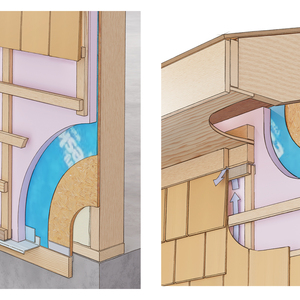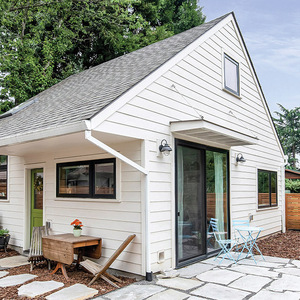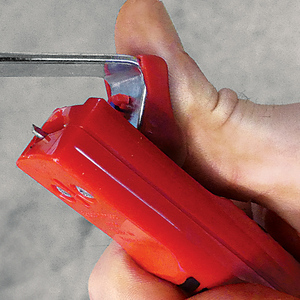Complicated GFI breaker tripping problem, can’t figure out why?
I have a situation where there is a Sq. D QO GFI Breaker in the panel that keeps tripping and I’m unable to find out why. Here are the facts: 1. The GFI has only 2 receptacles on it 2. The GFI also powers 1 toggle switch which turns on a flourescent light fixture overtop the kit.sink 3. The GFI also powers 1 toggle switch which turns on a single recess light fixture. 4. The GFI also powers an over the oven fan/light appliance. 5. Connections inside the boxes soldered with elec tape wrapping them. All boxes are metal. Romex wire was used and everything appears to be solidly grounded (boxes, switches, outlets). 6. I moved wires around inside boxes in case a wire somehow is touching a ground and then reinserted wires back in boxes. Whatever happened destroyed the GFI breaker. Every time I flip the breaker on it trips. Taking the wires off the breaker and turning it on causes it to trip. So I know the breaker is shot. There is a second GFI breaker in the panel. I removed the hot wire off that one and inserted the black wire of the troubled circuit into that GFI and turned it on. Prior to turning it on I turned OFF both toggle switches to the light fixtures and ensured the fan switch and fan/light switch was off also. The breaker stayed on w/out tripping. I plugged my tester in both outlets and got power w/out tripping. However, as soon as I flip on either toggle switch, or the fan/light the breaker immediately trips. I turn the switch back off, reset the breaker, and try the next switch, same thing. I repeat for the fan/light appliance, same thing. I was hoping that by flipping one of the switches I’d find a single fixture that was causing the problem, but it didn’t matter which one I flipped, it’d trip. What I did next was I removed one toggle switch from the circuit as a way to take that specific fixture out of the circuit. Reset the breaker and flipped on the other toggle switch, it tripped. I reset then turned on the fan/light, it tripped. So I reasoned it wasn’t the fixture whose switch I removed from the circuit. So I reinstalled that switch and removed the other toggle switch and repeated the same combo of tests, same thing, it’d trip. My last troubleshooting attempt then was to reinstall the toggle, and disconnect the fan/light over the oven. Reset breaker and flipped the toggles, it’d trip again. My attempts to isolate it down to one of the light fixtures, or one of the toggle switches, or the fan/light have been unsuccessful. This circuit worked fine for them for 20yrs until yesterday. Any ideas??? Need help!!!!!



















Replies
"5. Connections inside the boxes soldered with elec tape wrapping them. All boxes are metal."
Uhhhhh .... ???
Yes but I I moved wires around in case some might be touching, and still get problem.
I believe your testing is invalid because you did not move BOTH the black AND white wires of the "troubled circuit" to the "other GFI breaker" present in the panel.
As soon as you add a load to the GFI breaker (either light or the fan), it detects an imbalance between black and white connected to it and it trips - just like it it's 'sposed to! I suspect your tester did not add enough load to the circuit to trip the GFI when you tested at the outlets.
Try moving BOTH the black and white wires to the "spare GFI breaker" and repeat your testing. Consider adding a load to the outlets with all the toggles turned off / removed - a work light or table lamp will suffice.
Since this circuit has worked properly in the past with GFI breaker in place......if it works properly while being fed by the "spare GFI in panel" --- just replace the defective GFI breaker - they do go bad sometimes.
Good argument for not soldering connections - PITA to troubleshoot....get some wire nuts on those connections!
Good luck!
Jim
Edit: 20 years on a GFI breaker doesn't sound unreasonable for service life - could be it just died, and it's time for a new one!
Thanks, Jim, I never considered that my test is improper due to not moving both wires. Good thought, I need to do just that. I wonder if that improper test would cause it to trip as it was doing. It would, because it's looking on the neutral wire also and when I tried to flip on a light it has no white wire to monitor and trips, as the lights are using a real load. Whoa, I caused myself a lot of extra work last night. I was beat...7pm, was there 2.5hrs banging my head...you know how it is. Told owner I needed to walk away from it over night. He understood.
S-o-o-o-o, whad'ja find
S-o-o-o-o, whad'ja find out?
Jim
Disconnect the circuit completely from the panel. Check for any continuity from from the ground wire to neutral wire with a sensitive ohmmeter. There should be infinite resistance. Flip your toggles on and recheck.
There is a second GFI breaker in the panel. I removed the hot wire off that one and inserted the black wire of the troubled circuit into that GFI and turned it on.
That's guaranteed to trip, once you apply any load. A GFCI breaker has four connections:
-- The hot connection to the bus bar
-- The hot screw terminal
-- The pigtail wire for neutral (though I believe a few panels have a neutral bus for this)
-- A neutral screw terminal
To function correctly the pigtail must be attached to the neutral bar and the neutral from the circuit must attach to the neutral screw terminal. This is so the breaker can compare the "hot" current to the "neutral" current -- any difference means that juice is being bled off to ground somehow, meaning a short.
If you don't have the neutral properly configured then the currents will not match and the breaker will trip as soon as a load in applied to the circuit.
You say that the wires are soldered and taped. Unless you're being very foolish and doing this yourself, this suggests that this is a fairly old circuit, possibly knob and tube. Back in those "olden days" electricians (even knowledgeable ones) were not particularly careful to keep neutral lines for a given circuit isolated from other circuits. You cannot use a GFCI breaker on such a crossed-neutral circuit without some degree of rewiring.
My advice would be to give up on the GFCI breaker and install GFCI outlets.
Dan,
From OP:>>....This circuit worked fine for them for 20yrs until yesterday. <>..You cannot use a GFCI breaker on such a crossed-neutral circuit...<<
Don't think there are any crossed neutrals involved in this one....
Jim
Did it work fine for them with a GFCI breaker, or was that just added?
I got the impression from the OP that it worked with the now-malfunctioning GFCI breaker for those years. Or, perhaps the circuit has a recently developed problem.
20 years ago = 1989 or 1990 -- kitchen outlet circuit -- it would have not been unsual to be original equiptment. Square-D QO was certainly makin''em then.
Jim
PS: What the #%$& is "My Inbox" supposed to do anyway? I always check it, and always get the same thing - "No Messages" or some such. The only way to find out if someone has responded to one of my posts is to go troll around and hope I can remember where I posted.......
"My inbox" is just for e-mails.
they have e-mail notification working now for answers to your posts.
You have to click on profile in the box at top left of every page, click the EDIT tab and scroll down to the box labeled Comment follow up notification and check the Receive node follow-up notification e-mails check box.
throw away the gfci
are you that scared of electrons or have such a badly wire house? Maybe so, e.g taped connedtions...
>>>Maybe so, e.g taped connedtions...
Actually our code still allows for solder and tape, mostly in regard to "grandfathered" work that was done long ago. It used to be standard procedure before the days of wire nuts. If it's done properly it's fine, but of course is WAY more time consuming so you don't see much of it.
For own house (built 1973) all connections are crimped, then soldered, covered with the (tnen new) Ideal rubber crimp boots.
Betcha you will never see a house like mine with the outlet strings having the wire pulled thru the boxes without the copper being cut, but stripped and under the outlet screws.
It is interesting that Mil-std-275 shows the reliability of a crimped joint that is soldered as lower than simple crimp. The factor is poor solder skills, soldered mine myself
BTW, the ONLY GFCI in my own house are in cardboard boxes on the shelf <G@) GFCI and arc fault breakers in residential situations all are POS IMO, just a way to make $$$$.
Found a 55 era home that had a "western union" splice, without any solder. It only feed a light, but it was still tight. And the wrapping was very neat and tight. Looked like some wire wrapped connection using a power tool.
For those that don't know a Western Union splice is where a short section of insulation is removed and the tap is wrapped tightly around it and solder. Used for tapping into aerial lines.
Bill - is a western union splice the same as an "Edison splice" as was used with K&T?
I understand that Edison splices are still allowed when tapping into K&T but have to be soldered.